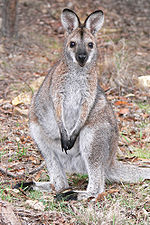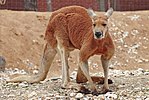The Macropodidae are an extant family of marsupial with the distinction of the ability to move bipedally on the hind legs, sometimes by jumping, as well...
7 KB (840 words) - 17:15, 12 November 2024
Macropodidae is a family of marsupials that includes kangaroos, wallabies, tree-kangaroos, wallaroos, pademelons, quokkas, and several other groups. These...
19 KB (1,900 words) - 20:03, 18 November 2024
PMID 28510900. Rofe RH (December 1978). "G-banded chromosomes and the evolution of macropodidae". Australian Mammalogy. 2: 50–63. doi:10.1071/AM78007. ISSN 0310-0049...
103 KB (5,184 words) - 04:33, 19 October 2024
Tim Flannery (category Fellows of the Australian Academy of Science)
of possums. As part of his doctoral studies, he reviewed the evolution of Macropodidae and described 29 new fossil species, including 11 new genera and...
82 KB (7,821 words) - 10:55, 22 November 2024
Marsupial (redirect from Evolution of marsupials)
numbers. For instance, members of the Macropodidae family, including kangaroos and wallabies, have a dental formula of 3/1 – (0 or 1)/0 – 2/2 – 4/4. Many...
76 KB (7,774 words) - 01:16, 20 November 2024
Kangaroo (redirect from Sexual behavior of kangaroos)
Kangaroos are marsupials from the family Macropodidae (macropods, meaning "large foot"). In common use the term is used to describe the largest species...
69 KB (7,562 words) - 12:40, 26 September 2024
Notamacropus (category Marsupials of Australia)
Notamacropus is a genus of small marsupials in the family Macropodidae, commonly known as wallabies (among other species). The term is derived from the...
4 KB (271 words) - 06:10, 16 June 2024
subfamily within the marsupial family Macropodidae, known as short-faced kangaroos or sthenurine kangaroos. No members of this subfamily are extant today,...
4 KB (374 words) - 14:03, 18 September 2024
Macropus (category Marsupials of Australia)
Macropus is a marsupial genus in the family Macropodidae. It has two extant species of large terrestrial kangaroos. The term is derived from the Ancient...
5 KB (387 words) - 14:57, 20 January 2024
Osphranter (category Marsupials of Australia)
Osphranter is a genus of large marsupials in the family Macropodidae, commonly known as kangaroos and wallaroos (among other species). It contains the...
4 KB (289 words) - 16:59, 3 March 2024
Bipedalism (redirect from Evolution of bipedalism in humans)
1988). "The Phylogenetic Position of the Musky Rat-Kangaroo and the Evolution of Bipedal Hopping in Kangaroos (Macropodidae: Diprotodontia)". Systematic Biology...
80 KB (9,571 words) - 18:49, 7 November 2024
Protemnodon (category Pliocene mammals of Australia)
"A new genus of kangaroo (Marsupialia, Macropodidae) from the late Pleistocene of Papua New Guinea". Transactions of the Royal Society of South Australia...
7 KB (626 words) - 14:19, 19 July 2024
osteology-based appraisal of the phylogeny and evolution of kangaroos and wallabies (Macropodidae: Marsupialia)". Zoological Journal of the Linnean Society...
7 KB (459 words) - 20:03, 18 November 2024
Macropodiformes Family †Balbaridae: (basal quadrupedal kangaroos) Family Macropodidae: (kangaroos, wallabies and allies) Family Potoroidae: (bettongs, potoroos...
11 KB (1,018 words) - 19:48, 18 November 2024
Tree-kangaroo (redirect from Evolution of tree-kangaroos)
"Reproduction of Lumholtz's tree-kangaroo, Dendrolagus lumholtzi (Marsupialia : Macropodidae) in captivity, with age estimation and development of the pouch...
21 KB (2,201 words) - 19:57, 17 August 2024
Bettong (category Marsupials of Australia)
evidence supports specific recognition of the recently extinct Bettongia anhydra (Marsupialia: Macropodidae)". Journal of Mammalogy. 96 (2): 287–296. doi:10...
6 KB (571 words) - 06:47, 18 October 2024
rat-kangaroo as its only member; the Potoroidae, with 10 species; and the Macropodidae which had 53 members in Australia, but some species are extinct. The...
17 KB (2,116 words) - 01:36, 15 November 2024
Australidelphia (category Marsupials of Australia)
feather-tailed possum Family Hypsiprymnodontidae: musky rat-kangaroo Family Macropodidae: kangaroos, wallabies, and allies Family †Thylacoleonidae: marsupial...
10 KB (558 words) - 23:05, 18 June 2024
Convergent evolution—the repeated evolution of similar traits in multiple lineages which all ancestrally lack the trait—is rife in nature, as illustrated...
137 KB (14,871 words) - 16:02, 18 November 2024
East African springhare (category Mammals of Kenya)
resembles a small kangaroo (a marsupial in the family Macropodidae of Oceania), and is about the size of a rabbit (Oryctolagus cuniculus). It is mid-brown...
4 KB (376 words) - 14:47, 29 July 2024
Dingiso (category Marsupials of New Guinea)
on leaves or other plant matter. It belongs to the macropodid family (Macropodidae) with kangaroos, and carries its young in a pouch like most other marsupials...
5 KB (572 words) - 01:38, 1 March 2024
Sugar glider (category Least concern biota of Oceania)
flying squirrel, despite not being closely related—an example of convergent evolution. The scientific name, Petaurus breviceps, translates from Latin...
53 KB (5,888 words) - 22:40, 27 September 2024
Macropodiformes has 72 species in 3 families: Hypsiprymnodontidae, Macropodidae, and Potoroidae, and includes kangaroos, wallabies, bettongs, potoroos...
133 KB (8,935 words) - 07:47, 18 November 2024
Wondiwoi tree-kangaroo (category Marsupials of New Guinea)
feed on plant matter. Tree-kangaroos belong to the macropod family (Macropodidae) with kangaroos, and carry their young in a pouch like most other marsupials...
11 KB (1,222 words) - 22:29, 3 March 2024
Banded hare-wallaby (category Vulnerable fauna of Australia)
osteology-based appraisal of the phylogeny and evolution of kangaroos and wallabies (Macropodidae: Marsupialia)". Zoological Journal of the Linnean Society...
10 KB (1,098 words) - 22:02, 15 March 2024
Petauridae (section Evolution)
similarities to the unrelated flying squirrels are an example of convergent evolution. The striped possums, on the other hand, are thought to have evolved...
4 KB (471 words) - 19:29, 31 October 2024
Procoptodon (category Pleistocene mammals of Australia)
ISBN 9780520916050. Haaramo, M. (2004-12-20). "Mikko's Phylogeny Archive: Macropodidae - kenguroos". Archived from the original on 2007-03-31. Retrieved 2007-03-15...
19 KB (1,989 words) - 06:41, 26 July 2024
Red kangaroo (redirect from Sexual behavior of red kangaroos)
of kangaroos (Marsupialia-Macropodidae)". Mammal Review. 4 (1‐2): 1–59. doi:10.1111/j.1365-2907.1974.tb00347.x. Serventy, Vincent (1985). Wildlife of...
29 KB (3,260 words) - 03:54, 31 October 2024
Koala (redirect from Breeding behavior of koalas)
anatomy of Oligo-Miocene koalas (Diprotodontia: Phascolarctidae): Stages in the evolution of an extreme leaf-eating specialization". Journal of Vertebrate...
89 KB (9,460 words) - 00:47, 20 November 2024
Wombat (category Marsupials of Australia)
differences in the Darug language. Though genetic studies of the Vombatidae have been undertaken, evolution of the family is not well understood. Wombats are estimated...
40 KB (4,117 words) - 21:25, 9 November 2024


























